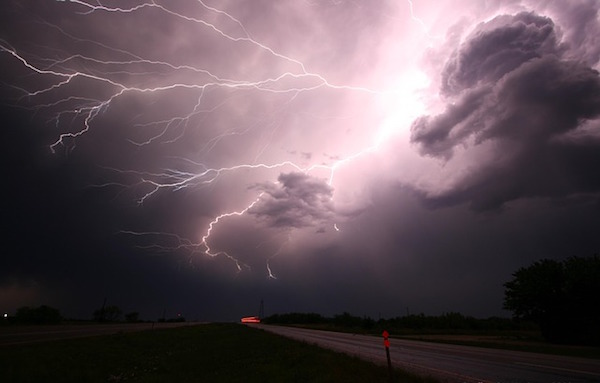
If you’re considering installing a lightning protection system, here’s a statistic to consider. According to data compiled by Westinghouse Electric Company, given an average location and exposure, a 50 ft. high building stands a greater chance of being struck by lightning once a year than a card player has of filing an ordinary flush in a poker game. In the United States the average geographic area is subjected to 40 lightning strikes per square mile every year. That’s a lot of lightning! Of course, not every one of those strikes is going to do damage to person or property, and many homes are situated to be less likely targets for a lightning strike in the first place. Lightning rod installation is not necessary for every home, but for those situated in areas where lightning is a frequent threat, lightning protection systems are excellent investments.
How Lightning Protection Systems Work
A lightning protection system is made up of several components. Lightning rods (air terminals) are the easiest part of the system to spot, but other components like surge arrestors and secondary conductors are also involved. Each component of a lightning protection system is designed to channel a lightning strike safely to the ground without causing harm to any part of the property; the rod provides a contact point, surge arrestors protect electrical equipment and wiring, secondary conductors prevent spark-over and side-flashes, and ground terminals carry electricity into the earth, where it is harmlessly dispersed.
Contrary to how they might seem to function, lightning rods do not “attract” lightning. Their sole-function is to act as a contact point so the lightning can be harmlessly grounded. The presence of a lightning rod doesn’t draw lightning towards the home, but if lightning does strike, having a lightning rod in place gives the energy from the bolt a fast and effective path to the ground.
Where Lightning Rod Installation Is Most Appropriate
The fact is: Given the right circumstances, lightning can strike just about anywhere. However, lightning protection systems are likely to be more beneficial to certain properties in specific environments. Homes on the edges of large bodies of water are often more at risk of lightning strikes, as are houses built in large expanses of flat lands or on mountain tops. Tall buildings in urban areas are also of particular concern. While lightning rod installation is appropriate in many other situations, homeowners in any of these settings should seriously consider installing a lightning protection system if one is not already in place.
Ready to start your lightning protection?
Find ProsLightning Protection System Companies
Companies that specialize in installing lightning protection systems are well-versed not only in the components of the systems they offer, but in lightning safety in general. While a company that sells lightning rods will certainly be able to tell you if your home makes a particularly likely target, they will also be able to give you advice on how to make your property safer by means other than lightning protection systems.
Lightning rod system installation costs and lightning arrestor prices can vary depending on your home size and location. Hire a professional to evaluate your home’s risk of a strike.
Lightning Protection Through Landscaping
If is not uncommon for a professional to suggest alterations in landscaping to reduce the chances (or reduce the potential property damage) of lightning strikes. In most normal situations, lightning strikes are difficult to predict with a high amount of accuracy, but alterations like removing tall trees or certain overhanging limbs or changing the location of a flag pole may lower your chances of a strike causing severe property damage; when such alterations are suggested by a professional, they should, of course, be given careful consideration!
 Staying Safe During a Home Power Outage
Staying Safe During a Home Power Outage  Electrical Safety
Electrical Safety  11 Home Security and Safety Tips
11 Home Security and Safety Tips  Powerful Electrical Upgrades
Powerful Electrical Upgrades 

In the building (high rise) a lightning protection is installed every 100 square meter. Also, the trees shall be also provided with lightning protection. All metallic shall be grounded. A grounding cable from the rod shall be insulated. to the height of a person, because there’s a trip hazard to any person touching if the grounding cable is not proper crimp. Also, avoid touching any wire/cable in the event of lightning strike, the wire/ cable become live. If the lightning strike is very near to your location. It is funny to think of, but it happened to my friend 40 years ago. The wire that being used as hanger for the clothes from end to end become hot voltage is presence. He detached his hand hurriedly without damaged in his hand. One of my friend experiencing damaged in the lighting circuit when a lightning strike in their house. They installed a lightning protection. From that time no more re-occurence. An LRT/ MRT transmission line in our location they experience a lightning strike. It is funny things, because during the construction stage, as per standard it is always provided with the lighting protection. As I heard in the news they already provided with lightning Protection. In other standard they used 25 ohms other standard the uses 1 ohms earth resistance. 2 ohms resistance for instrumentation.